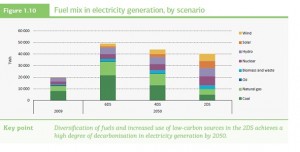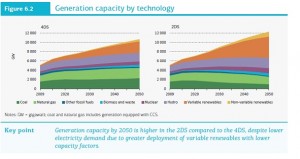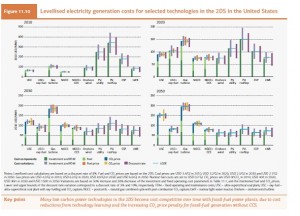The obvious answer to a low carbon electricity system – More Nuclear Power
I started writing this while sitting on the very long plane ride on my way to China. The Rio+20 conference had just started, the largest ever UN conference and yet it was receiving relatively little press. I remember the first Rio conference 20 years ago when there was so much hope for the environment and the conference was seen as an important beginning in addressing climate change. Now 20 years later, expectations were low and interest even lower. I guess it’s not surprising. With economic crisis ongoing in Europe, a weak recovery in the US and a slowdown in China, environmental issues have fallen way down on many people’s list of priorities.
In advance of this conference, the IEA recently issued its Energy Technology Perspectives Study (ETP 2012), where they make a passionate case in support of the environment and the need to develop a low carbon energy system. Love it or hate it, this study is a gold mine of interesting and useful information in its almost 700 pages. This study takes the 450 ppm scenario in the World Energy Outlook 2011 and extends it out to 2050, now calling it the 2 degree scenario (2DS). This is then compared to the status quo (6 degree scenario) with a 4 degree scenario in between. It then goes a step further to see if a zero emissions energy system is possible by 2075. It is just not possible to discuss the entire study in one short (actually not so short) blog post, so I will focus on a few key issues and will likely continue to use it as a valuable source of data in future postings.
The study makes the case that environment and energy development must go hand in hand. Here are some of the findings:
- A sustainable energy system is still within reach and can bring broad benefits
- Technologies can and must play an integral role in transforming the energy system.
- Investing in clean energy makes economic sense – every additional dollar invested can generate three dollars in future fuel savings by 2050.
- Energy security and climate change mitigation are allies.
- Despite technology’s potential, progress in clean energy is too slow
- Nine out of ten technologies that hold potential for energy and CO2 emissions savings are failing to meet the deployment objectives needed to achieve the necessary transition to a low-carbon future. Some of the technologies with the largest potential are showing the least progress.
- The share of energy-related investment in public research, development and demonstration (RD&D) has fallen by two-thirds since the 1980s.
- Fossil fuels remain dominant and demand continues to grow, locking in high-carbon infrastructure.
It then goes on to focus on how energy policy must address the key issues and the role of government in making it all happen, finally concluding with recommendations to energy ministers (assuming these recommendations were to be considered at Rio+20).
When considering “technologies” the focus is on renewable technologies such as wind and solar, energy efficiency technologies to reduce demand and carbon capture technologies to clean up the ever-expanding fossil infrastructure. Nuclear is also shown to be important although it role is somewhat less than the other technologies. It is these same technologies, primarily renewable and Carbon Capture and Sequestration (CCS) they are talking about when they say “progress in clean energy is too slow”
Focusing on a few key issues, consider the following two figures. The first illustrates the change in electricity generation mix for each of the three scenarios. Improved energy efficiencies is the most important source of clean generation. The figure shows that in the 6DS there is almost 50,000 TWh of generation required dropping to about 40,000 TWh in the 2 DS. It can be seen that there is huge growth in renewable generation (wind, solar, hydro and biomass) and an increase in nuclear capacity. Most of the remaining fossil generation is assumed to have CCS installed.

The next figure is somewhat more telling. It shows the needed capacity and illustrates that due to the variability and low capacity factors of renewables such as wind and solar, capacity must still increase even though total generation decreases by 20% (50,000 to 40,000 TWh Fig 1.10). This demonstrates the importance of nuclear as it has high efficiency relative to other forms of generation. With less than 5% of the generating capacity (about 550 GW), it produces close to 20% of the electricity! i.e. nuclear is an essential technology in a low carbon electricity system.

The main tool in achieving CO2 reduction targets for the 2DS is CO2 price, increasing from USD 40/tCO2 in 2020 to USD 150/tCO2 in 2050. This greatly increases the electricity generation costs of CO2-emitting technologies and thereby improves the relative cost-competitiveness of low-carbon power technologies. The following figure is a bit busy but important as it clearly shows how CO2 pricing is implemented to achieve this result.

The cost increase to effect change is one of the key points made in Jeff Rubin’s new book “The end of Growth”. In an excerpt published in the Globe and Mail on May 5, Jeff talks about the electricity and transport systems in Denmark. The Danes have achieved a heroic drop in carbon emissions of 13% over the past twenty years while those of us in North America have seen an increase in emissions of 30% in the same time period. Often praised for its commitment to renewable energy, now producing 20% of its electricity from wind power, what often goes unsaid is that the remaining 80% of its electricity is generated by coal.
So how is Denmark achieving this great carbon reduction? Simple – price. At $0.30/KWh, the price of electricity in Denmark is 2 to 3 times higher than in most jurisdictions in North America. And at this relatively high price has a significant impact on behaviour and usage drops dramatically.
This is absolutely consistent with the IEA report as it suggests the only way to achieve a low carbon world is to price carbon aggressively to force behavioural change; first by reducing demand and second through the implementation of higher cost low carbon technologies.
Now while this may work in Denmark and in other countries where there is no choice but to implement higher prices to manage the transition such as in Japan and Germany (due to their need to replace idled nuclear), any politician who takes the position of significant increases in energy costs in North America will not keep his or her job for very long. In North America the population believes that cheap and abundant energy is a right and anyone who tries to say we need to do otherwise won’t make it very far at voting time.
So what are we to do? I do believe that the IEA’s ETP report has this answer as well. And for us in the nuclear industry it has always been quite clear. More nuclear power.
I have talked about the IEA’s nuclear roadmap before. In effect, they prepared a number of “roadmap” reports for various technologies and this ETP report is where they bring them all together in a cohesive model of a clean energy system for the future. When it comes to nuclear the IEA continues to be positive and sees an increase in nuclear generation from about 14% of electricity supply to almost 20% in 2050. While the increase in nuclear capacity may appear to be modest, as stated earlier this modest capacity provides a significant portion of the needed electricity generation!
It should be noted that this target represents a decrease from their original target of 24% in their nuclear roadmap due to the impact of the Fukushima accident on public acceptance which has become the limiting issue. This is based on a 2011 post Fukushima survey in which support for nuclear power drops due to an increased concern about nuclear safety with more people now supporting nuclear shutdown due to its inherent dangers.
Of importance, the study continues to include a “high nuclear” sensitivity case for the 2DS scenario. In the 2DS-hiNuc case, nuclear generation is increased to 34% in 2050. Compared with the base 2DS, nuclear replaces fossil power plants with CCS and renewables, whose share in 2050 falls: in the case of CCS from 15% to 7%, and in the case of renewables from 57% to 49%. This scenario reflects a world with greater public acceptance of nuclear power. On the technical side, the average construction rate for nuclear power plants in the period 2011 to 2050 rises from 27 GW/yr in the base 2DS to 50 GW/yr. The cumulative investment costs of this case are only USD 0.2 trillion higher than in the base 2DS and are more than offset by costs savings for fossil fuels in the order of USD 2 trillion (10 to 1).
Going back to the cost figure above, this is not surprising because nuclear is competitive with other forms of generation and can be built now without the need for high carbon costs to incentivise it. (I know in North America current low gas prices are challenging new nuclear and this was my topic last time – but keep in mind this study is looking at the bigger picture over a longer timeframe).
A system with about one third of the generation provided by nuclear seems very sensible and achievable so long as the industry can overcome the major issue of public acceptance. Therefore the challenge is clear. The industry should focus on the high nuclear scenario as our base case and work hard to regain public trust – no small task that will certainly require a long term sustained effort.
In the end, our world will become more electrified and we need to move forward with a cleaner, sustainable electricity system for our future. So what is harder for the public to accept – very high carbon costs and a very large increase in variable renewable generation or a bigger role from a relatively modest increase in the number of nuclear power plants??